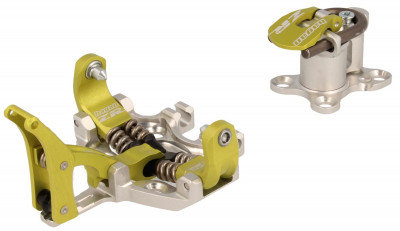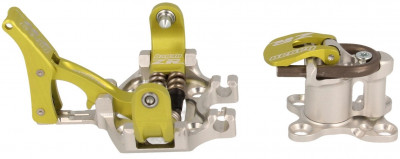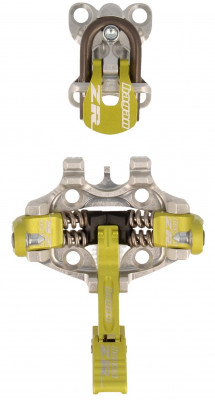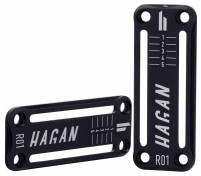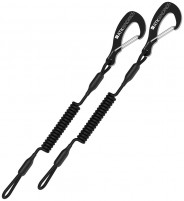I got into ski mountaineering through the side door. I was really into freeriding, but couldn’t afford helicopter time. If I wanted to ski the lines I saw in movies, I was going to have to climb them first. After a short time, climbing + skiing became the thing I was after. If I couldn’t climb it, I didn’t really care about skiing it. This created the paradigm shift that lead to me embracing race gear as viable equipment and my purchase of a set of Hagan ZR bindings.
I’m 195lbs at the time I’m writing this, and not known for my great finesse in most matters.
I entered the realm of race weight gear with a great deal of skepticism that it would reliably work for me.
Naturally my skepticism and geekiness have lead me to put this binding through its paces in all kinds of snow to see if I could make it fail. Ice, sastrugi, groomers, powder, corn, all of it. I’ve skied with the toes locked, and unlocked, with a variety of different boots and have not suffered a pre-release, or failure of any component.
The construction is simple, clean and elegant. It’s one of the lightest race bindings available, but also one of the best functioning. Step-in and out is clean and concise. Locking and unlocking the toes is so smooth and never ices up. On two occasions, I’ve taken falls where I was praying for a release and the ZR did not fail me. It let go quick and clean.
I like that the crampon receptor is machined beautifully into the toe piece. It frustrates me that other manufacturers often do not include this essential part of a toe piece.
If this binding didn’t have such a high price tag, I believe it would likely be the de-facto standard for most users seeking a binding in this class. While it is more expensive than others, I’ve found the confidence this binding provides is worth the extra money.
Please meet the new Hagan ZR Race binding! At 116 grams (4.1 ounces), it is now the lightest binding available in North America. The ZR is made by ATK, an Italian company with a proven track record of making award winning tech bindings. But now thanks to Hagan, the Euros won’t be the only ones to enjoy the clever combination of light-yet-strong materials. Best of all, skimping on grams doesn’t mean skimping on features:
- Simple flap above the heel pins lets you change easily between uphill and downhill modes.
- Heel rotates 90 degrees in either direction for flat-on-ski touring mode**.
- Built in attachment receptor accepts any standard tech binding crampon.
- Optional adjustment plates give you the ability to change boots in the future.
- Titanium fork in the heel is specially treated to ease entry and reduce wear.
- 77 gram toe and 39 gram heel piece provide you no excuses on a slow day.
** Note Hagan/ATK suggest mounting the binding with a 5.0-5.5mm heel gap (versus the default 4.0) to fully enable this feature.
Update 2016/17: The ZR now shines yellow like the star it has become.
| Specifications | |
|
Weight |
116g |
| Weight (pair) | 232g |
|
Boot |
Tech |
|
Brakes |
None |
|
BSL |
Accessory plates |
|
Riser |
1 + flat |
|
Vertical |
Fixed |
|
Lateral |
Fixed |
|
Crampon |
Yes |
| Specs Verified | Yes |
| Design | |
|
|
Hardened titanium, aluminum, polymer |
| Skimo Co Says | |
| Usage | Racing |
| Notes | Proven design from ATK |
| Bottom Line | Light & stiff |
| Compare to other Race Bindings | |
Related Products
$57.95 $52.95
$37.95
Questions & Reviews
5/28/2017
Comment on this review:
12/26/2016
If these are mounted with the adjustment plate will there be a problem with throwing them into flat tour mode with the spring loaded ball possible coming out?
12/26/2016
Hi Darrow, the flat mode works fine with the adjustment plates, the ball is still mostly contained within the tube and support by the plate.
Answer this question:
9/11/2014
These bindings are super light weight. I really like how polished the unit feels compared to the Trab race binding.
I have found a few drawbacks, however.
1) The pin cover has a tendency to loosen and not stay down. Thankfully this has not caused me to go into ski mode yet, but I have looked down and found my heel coming down on the pins with the cover raised. A little tightening of the screw made the action a bit stiffer and has fixed it for now. I prefer how the Trab cover is spring loaded, it will not lift up without intention.
2)My pins are becoming reasonably notched after 1 season. Yes, I know that these are so light in part due to titanium heel pins, but I did not anticipate my pins to be so notched after such a short period of time. I would take a little weight penalty for more durability on this front.
3) Though they claim a flat on ski mode, and it is technically possible, whenever I am in flat skinning mode, and on any type of rolling terrain(skidoo 'whoop-dee-doo' tracks are horrendous for this) my heel will get caught and it interrupts my stride and is very frustrating. Evidently you can mount the binding with a bit more of a pin gap(I mounted mine to 4mm spec) to make it work. I have just resorted to not using flat on ski mode. The heel metal has also been worn a bit where it was rubbing and getting caught.
Not to say it is a bad binding, it is incredibly light and does the job of a true race binding just fine. It is perhaps not as suited for other uses than dedicated racing though.
I have found a few drawbacks, however.
1) The pin cover has a tendency to loosen and not stay down. Thankfully this has not caused me to go into ski mode yet, but I have looked down and found my heel coming down on the pins with the cover raised. A little tightening of the screw made the action a bit stiffer and has fixed it for now. I prefer how the Trab cover is spring loaded, it will not lift up without intention.
2)My pins are becoming reasonably notched after 1 season. Yes, I know that these are so light in part due to titanium heel pins, but I did not anticipate my pins to be so notched after such a short period of time. I would take a little weight penalty for more durability on this front.
3) Though they claim a flat on ski mode, and it is technically possible, whenever I am in flat skinning mode, and on any type of rolling terrain(skidoo 'whoop-dee-doo' tracks are horrendous for this) my heel will get caught and it interrupts my stride and is very frustrating. Evidently you can mount the binding with a bit more of a pin gap(I mounted mine to 4mm spec) to make it work. I have just resorted to not using flat on ski mode. The heel metal has also been worn a bit where it was rubbing and getting caught.
Not to say it is a bad binding, it is incredibly light and does the job of a true race binding just fine. It is perhaps not as suited for other uses than dedicated racing though.
Comment on this review:
9/3/2014
Overall: A caveated Five Stars for the Hagan rebranding of the latest tweak of the ATK WC SL-R, a race binding that is outrageously light and innovative, even among lots of competition from other light and innovative race bindings. The major caveat for lightweight skiers: the effective lateral release value is at least somewhere in the low double digits (in contrast to a typical high single digits for the competition), and probably ditto for the forward release. The flip side of this caveat is a major benefit for any heavier skiers who are wary of the release values being too low on competing models.
Background on product familiarity: I have about 52,000’ skiing vertical on a pair of ZR bindings mounted on a 173cm Hagan Y-Flow (87mm waist) with Dynafit EVO boots, and about 100,000’ vertical on another pair mounted on a 163cm Hagan X-Race with Scarpa Alien 1.0 boots. My other race and near-race bindings include the Sportiva-rebranded ATK RT, Dynafit Low Tech Race, Dynafit Speed Superlite, Plum 135, Plum 165, and an ISMF-prohibited combination of Dynafit IV/Tech/Classic/Speed toe plus Plum 135 heel.
First, the first impressions out of the box: If you’ve never seen a rando race binding before, you’re in for a shock, although of the favorable kind, as this is a “Tech”-style binding stripped down to its absolute essentials. If you’ve seen other rando race bindings, the ZR looks generic at first, but actually has some innovative differences.
The toe lever is quite sophisticated, employing a little scroll wheel to move along a track very definitively into its full locking position. I’m not sure if this has any practical effect or improvement relative to the more typical friction-based design, but it definitely exhibits some admirable innovation and attention to detail. The fully locked position is not entered into automatically, as the wheel encounters some resistance along the track. The wheel can apparently be removed so as to automatically enter a fully locked position, but in potential violation of ISMF regs (for those with international competition aspirations), and with questionable benefit (given the properties of the automatically entered position, as described later on here).
The ski crampon attachment is permanently integrated (ATK’s “SL” model sans “R” truncates that part), which is impressive given both the weight and price.
The toe mounting pattern is the de facto standard for rando race bindings, using the older Dynafit pattern (i.e., pre-Radical) while skipping the fifth center hole. The heel pattern is the de facto standard of no standard (i.e., unique to each model), although the four holes are somewhat wider and longer compared to the competition. (See Skimo’s “Hole Pattern Recognition” article for more details.)
And before mounting, don’t rotate that heel unit more than 45 degrees! The lateral release function of a typical race binding depends on some mysterious internal workings packed around the heel pedestal. The ZR instead has an external column behind the pedestal, with a spring-loaded ball that can move in either direction along a grooved track. If the binding moves beyond this track once mounted to a ski, the ball just rests on the ski topskin, and can easily be rotated back into position. But if the rotation occurs before mounting, then the ball will be liberated by the spring off into … somewhere. (Fortunately I was forewarned!) Once mounted, the entire heel unit rotates by hand with what feels to be resistance typical of a race binding.
As with all full-on race bindings, the heel cover offers only a single kind of “half-step” elevator position, which is optimal for optimal skin tracks, but feels a bit too low for too-steep skin tracks. (The ZR is about 1mm lower than the Dynafit Low Tech Race, and 4mm lower than the Plum 135/145.)
For extended flats, you can rotate the heel unit for no elevator at all. But to skin this way without the heel unit housing jamming up against the back of your boot heel, the binding needs to be mounted not at the standard gap of 4.0mm but instead at around 5.0 to 5.5mm, a practice that ATK officially endorses for that purpose. (See Skimo’s “Mind the Heel Gap” article for more details.) However, in addition to potentially changing the retention and release characteristics, your boot heel would be resting directly on the ski topskin for a slightly negative skinning position.
As is also typical of race bindings, the heel > toe “delta” for skiing is very low, which helps with fore-aft balance. (By contrast, more binding “delta” puts almost all skiers more into the backseat – think of where your hips go when hiking down a steep pitch.) Even for race bindings, the ZR’s delta is among the lowest. (See Skimo’s “Binding Pin Heights” article for more details.)
Second impressions, in use: The toe retention is stronger than touring-oriented Dynafit or other Tech-style bindings, although this is typical of other race models. This effect on the ZR appears to be a manifestation of the heavily spring-loaded toe lever, as opposed to any difference in the spring of the pincer springs. Either way, the ultimate effect was born out by testing the ZR in skinning mode with a VSSE Release Calibrater and also in the field: I kept the toe lever in ski mode for almost all my skinning, moving the toe lever into the locked position only when using ski crampons or other potentially dicey situations. (By contrast, I can barely skin anywhere at all in touring-oriented models with the toe lever in ski mode.)
The ski crampon attachment has worked fine for my Dynafit Speed 82 crampons, and also for some Dynafit 90 crampons that I briefly tested. (The attachment is also reported to work fine of course for Hagan’s rebranded ATK crampons). The attachment is much wider and seemingly stronger than some of the minimalist removable clasps on some of the competition. The potential drawback of that is by contrast those other minimalist claps can be bent slightly to accommodate manufacturing tolerances in other crampons that might not otherwise fit well.
I have never prereleased, despite skiing them sometimes in-bounds just as I would my alpine downhill race gear (even in tight moguls!), and despite some backcountry descents on “firm” steep uneven “snow” that I would prefer not to recall now in detail. The coupling between the boot and the ski feels as tight as with any Dynafit or other “Tech”-style binding.
Fortunately I have never had the chance to test the release characteristics in a fall. And I did not test the lateral release values immediately after mounting with my VSSE Release Calibrater since I was pressed for time during ski season, and since the rotation of the entire heel unit by hand had seemed typical. This summer though, I found a surprise: at least somewhere in the low double digits. The “at least” qualifier is that I never could get it to release with my setup, although that is mainly a function of my limited arm strength, and anyway the official release value charts end after the low double digits. With carpet testing, I could twist out laterally, but just barely, with a force probably consistent with an estimate of at least somewhere in the low double digits.
This high value is a function of how the U-shaped pin is secured vertically yet allowed to flex out horizontally in a wide slot. Hence the spring-loaded ball doesn’t start moving along its defined track until the outer arm of the titanium is flexed out to its maximum extent. (I am fairly sure that the high value is not a function of the heavily spring-loaded toe lever: when I used a strap to negate the spring’s influence, the skinning mode release value decreased to a typical touring binding, but the ski mode release value was unaffected.)
I haven’t formally tested the forward release value, but I suspect it’s also on the high side, given the greater force required to step into the binding. I usually didn’t notice this except on deep powder days, when I needed to stomp out a platform a bit more and then step down with my heel much harder than usual. For a typical race-day transition zone though, this was not noticeable. (And when the powder was deep enough to cause this problem, I was so happy otherwise that I didn’t mind a more forceful entry before skiing!) But as with the high lateral release, this is a major caveat for lightweight skiers, yet a major benefit for heavier skiers who are wary of the release values being too low on other race bindings.
Third impressions, for long-term durability: Still good as new, except for the titanium U-shaped heel spring, which is starting to become notched very slightly. This latest version has a coating intended to reduce wear, but my calculations show a wear rate typical of the titanium springs from Plum and Dynafit: about 0.1mm for every 30,000’ of skiing at my weight. So probably somewhere between around 200,000’ and 300,000’ vertical the notching might lead to a noticeably “rattly” feel while skiing, and eventually the notches will cause the pins to become hook-like so as to interfere with lateral release.
Fortunately you don’t have to worry about breakage, since the greater strength of titanium (as opposed to steel) will compensate for the notched metal until you retire the pins for either the rattling or the compromised release. And the pins are designed to be easy to remove for replacements that will be available from Hagan.
Background on product familiarity: I have about 52,000’ skiing vertical on a pair of ZR bindings mounted on a 173cm Hagan Y-Flow (87mm waist) with Dynafit EVO boots, and about 100,000’ vertical on another pair mounted on a 163cm Hagan X-Race with Scarpa Alien 1.0 boots. My other race and near-race bindings include the Sportiva-rebranded ATK RT, Dynafit Low Tech Race, Dynafit Speed Superlite, Plum 135, Plum 165, and an ISMF-prohibited combination of Dynafit IV/Tech/Classic/Speed toe plus Plum 135 heel.
First, the first impressions out of the box: If you’ve never seen a rando race binding before, you’re in for a shock, although of the favorable kind, as this is a “Tech”-style binding stripped down to its absolute essentials. If you’ve seen other rando race bindings, the ZR looks generic at first, but actually has some innovative differences.
The toe lever is quite sophisticated, employing a little scroll wheel to move along a track very definitively into its full locking position. I’m not sure if this has any practical effect or improvement relative to the more typical friction-based design, but it definitely exhibits some admirable innovation and attention to detail. The fully locked position is not entered into automatically, as the wheel encounters some resistance along the track. The wheel can apparently be removed so as to automatically enter a fully locked position, but in potential violation of ISMF regs (for those with international competition aspirations), and with questionable benefit (given the properties of the automatically entered position, as described later on here).
The ski crampon attachment is permanently integrated (ATK’s “SL” model sans “R” truncates that part), which is impressive given both the weight and price.
The toe mounting pattern is the de facto standard for rando race bindings, using the older Dynafit pattern (i.e., pre-Radical) while skipping the fifth center hole. The heel pattern is the de facto standard of no standard (i.e., unique to each model), although the four holes are somewhat wider and longer compared to the competition. (See Skimo’s “Hole Pattern Recognition” article for more details.)
And before mounting, don’t rotate that heel unit more than 45 degrees! The lateral release function of a typical race binding depends on some mysterious internal workings packed around the heel pedestal. The ZR instead has an external column behind the pedestal, with a spring-loaded ball that can move in either direction along a grooved track. If the binding moves beyond this track once mounted to a ski, the ball just rests on the ski topskin, and can easily be rotated back into position. But if the rotation occurs before mounting, then the ball will be liberated by the spring off into … somewhere. (Fortunately I was forewarned!) Once mounted, the entire heel unit rotates by hand with what feels to be resistance typical of a race binding.
As with all full-on race bindings, the heel cover offers only a single kind of “half-step” elevator position, which is optimal for optimal skin tracks, but feels a bit too low for too-steep skin tracks. (The ZR is about 1mm lower than the Dynafit Low Tech Race, and 4mm lower than the Plum 135/145.)
For extended flats, you can rotate the heel unit for no elevator at all. But to skin this way without the heel unit housing jamming up against the back of your boot heel, the binding needs to be mounted not at the standard gap of 4.0mm but instead at around 5.0 to 5.5mm, a practice that ATK officially endorses for that purpose. (See Skimo’s “Mind the Heel Gap” article for more details.) However, in addition to potentially changing the retention and release characteristics, your boot heel would be resting directly on the ski topskin for a slightly negative skinning position.
As is also typical of race bindings, the heel > toe “delta” for skiing is very low, which helps with fore-aft balance. (By contrast, more binding “delta” puts almost all skiers more into the backseat – think of where your hips go when hiking down a steep pitch.) Even for race bindings, the ZR’s delta is among the lowest. (See Skimo’s “Binding Pin Heights” article for more details.)
Second impressions, in use: The toe retention is stronger than touring-oriented Dynafit or other Tech-style bindings, although this is typical of other race models. This effect on the ZR appears to be a manifestation of the heavily spring-loaded toe lever, as opposed to any difference in the spring of the pincer springs. Either way, the ultimate effect was born out by testing the ZR in skinning mode with a VSSE Release Calibrater and also in the field: I kept the toe lever in ski mode for almost all my skinning, moving the toe lever into the locked position only when using ski crampons or other potentially dicey situations. (By contrast, I can barely skin anywhere at all in touring-oriented models with the toe lever in ski mode.)
The ski crampon attachment has worked fine for my Dynafit Speed 82 crampons, and also for some Dynafit 90 crampons that I briefly tested. (The attachment is also reported to work fine of course for Hagan’s rebranded ATK crampons). The attachment is much wider and seemingly stronger than some of the minimalist removable clasps on some of the competition. The potential drawback of that is by contrast those other minimalist claps can be bent slightly to accommodate manufacturing tolerances in other crampons that might not otherwise fit well.
I have never prereleased, despite skiing them sometimes in-bounds just as I would my alpine downhill race gear (even in tight moguls!), and despite some backcountry descents on “firm” steep uneven “snow” that I would prefer not to recall now in detail. The coupling between the boot and the ski feels as tight as with any Dynafit or other “Tech”-style binding.
Fortunately I have never had the chance to test the release characteristics in a fall. And I did not test the lateral release values immediately after mounting with my VSSE Release Calibrater since I was pressed for time during ski season, and since the rotation of the entire heel unit by hand had seemed typical. This summer though, I found a surprise: at least somewhere in the low double digits. The “at least” qualifier is that I never could get it to release with my setup, although that is mainly a function of my limited arm strength, and anyway the official release value charts end after the low double digits. With carpet testing, I could twist out laterally, but just barely, with a force probably consistent with an estimate of at least somewhere in the low double digits.
This high value is a function of how the U-shaped pin is secured vertically yet allowed to flex out horizontally in a wide slot. Hence the spring-loaded ball doesn’t start moving along its defined track until the outer arm of the titanium is flexed out to its maximum extent. (I am fairly sure that the high value is not a function of the heavily spring-loaded toe lever: when I used a strap to negate the spring’s influence, the skinning mode release value decreased to a typical touring binding, but the ski mode release value was unaffected.)
I haven’t formally tested the forward release value, but I suspect it’s also on the high side, given the greater force required to step into the binding. I usually didn’t notice this except on deep powder days, when I needed to stomp out a platform a bit more and then step down with my heel much harder than usual. For a typical race-day transition zone though, this was not noticeable. (And when the powder was deep enough to cause this problem, I was so happy otherwise that I didn’t mind a more forceful entry before skiing!) But as with the high lateral release, this is a major caveat for lightweight skiers, yet a major benefit for heavier skiers who are wary of the release values being too low on other race bindings.
Third impressions, for long-term durability: Still good as new, except for the titanium U-shaped heel spring, which is starting to become notched very slightly. This latest version has a coating intended to reduce wear, but my calculations show a wear rate typical of the titanium springs from Plum and Dynafit: about 0.1mm for every 30,000’ of skiing at my weight. So probably somewhere between around 200,000’ and 300,000’ vertical the notching might lead to a noticeably “rattly” feel while skiing, and eventually the notches will cause the pins to become hook-like so as to interfere with lateral release.
Fortunately you don’t have to worry about breakage, since the greater strength of titanium (as opposed to steel) will compensate for the notched metal until you retire the pins for either the rattling or the compromised release. And the pins are designed to be easy to remove for replacements that will be available from Hagan.
11/16/2016
Minor update for the 2016-17 season: the new yellow-ish version has a slightly thicker "trigger" for the toe wing pincers upon entry, which helps with some boots (e.g., certain pairs of Pierre Gignoux models) that are too thin for the older version.
Comment on this review:
2/23/2014
This binding is incredibly light. I have it mounted on the Movement Goldfish-X and after about 20,000 vertical feet I can say I love its performance on the up and the down. I have yet to lock the toe down while skiing and haven't had any pre-releases on terrain varying from deep powder to 42 degree double black slopes in the resort. I am not about to go off any jumps with them, but they have been great for touring even for a bigger guy like me at 6'2" and 185lbs plus a backcountry pack with all the essentials.
Comment on this review:
2/4/2014
I have used these now for about 7 sessions and all is as expected. Mostly skied them on very hard/icy snow. Before these I had another 2 pairs of ATK bindings and these are the best of the 3. Weight is also dead on according to my kitchen scale.
I will come back with more info as I keep using them but I don't expect major surprises as this is a time-tested binding.
I will come back with more info as I keep using them but I don't expect major surprises as this is a time-tested binding.
11/29/2014
All still well after many more sessions back in the spring.
12/12/2016
Update: After 3 seasons it continues to be my favourite race binding of all time. Mounting another pair on a new race setup soon.
Comment on this review:
Earn store credit by writing reviews. Learn more.






